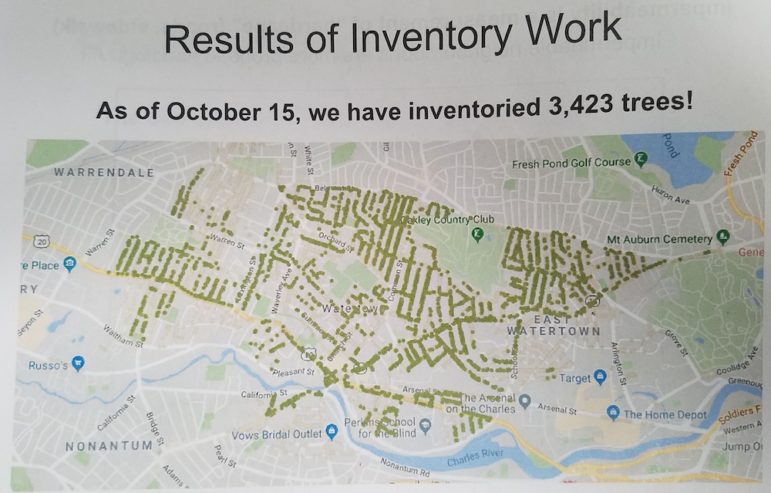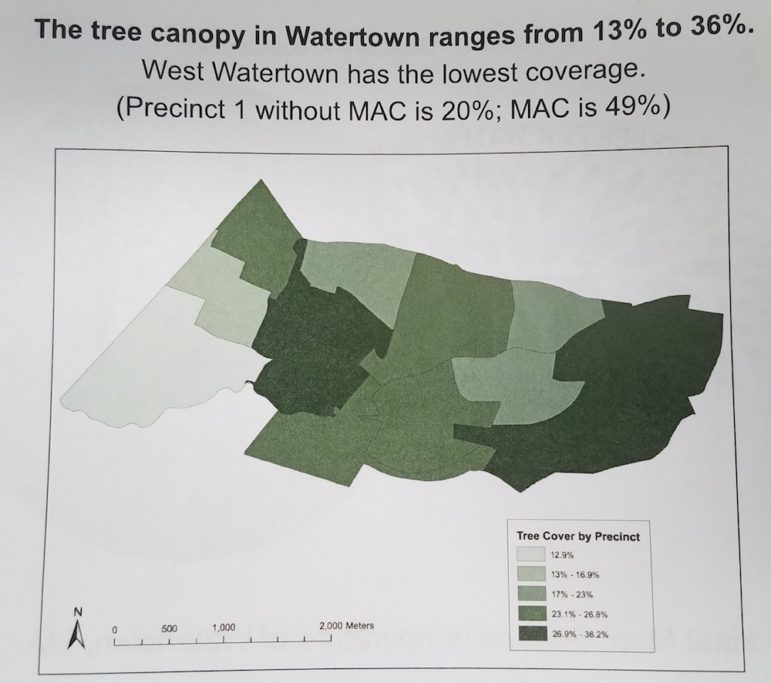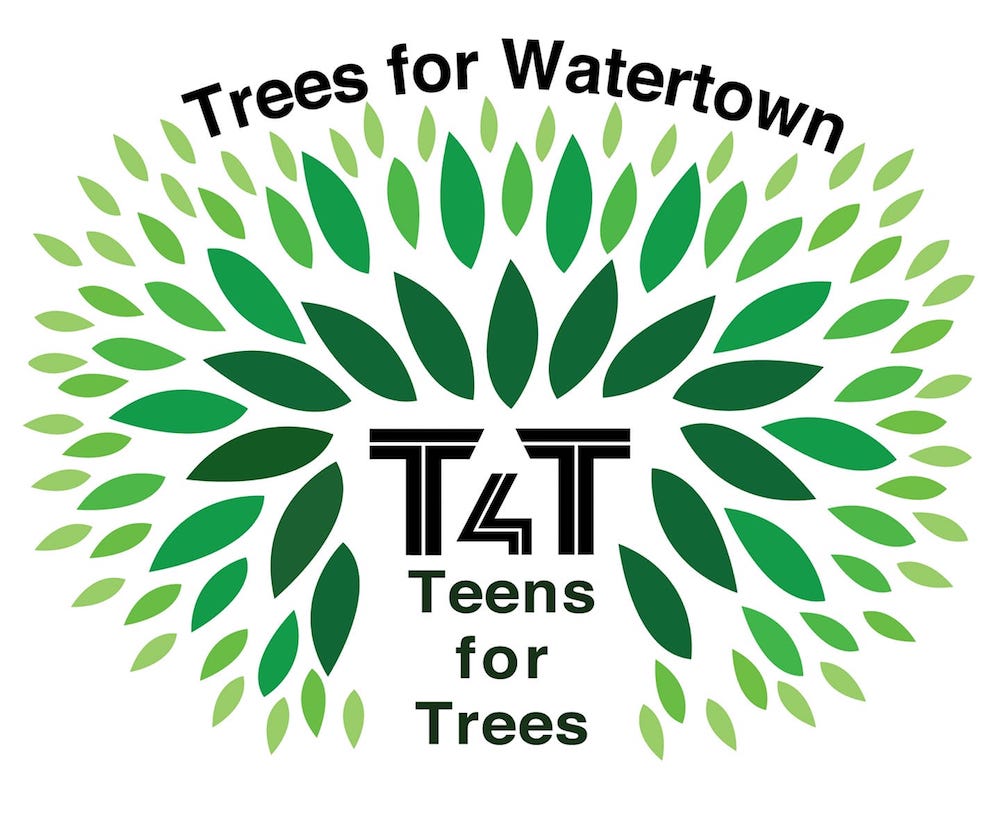
A map showing the trees cataloged by Watertown High School students over the summer.
Having trees on your street can reduce the heat in the summer, prevent flooding when it rains and can even increase property values. However, a study of street trees done by Watertown High School students found that many residents have few or no trees along their blocks.
Monday night, the results of a survey of more than 3,400 street trees around Watertown were presented to a joint meeting of the Town Council’s Public Works and Rules & Ordinances subcommittees. The group made a recommendation to the full Town Council to seek ways to use the data to bring trees to streets that lack them.
The data was presented by two members of Trees for Watertown, a citizens group committed to planting and maintain trees in town. Trees for Watertown (TFW) President Libby Shaw told the Councilors about the importance of trees.
“We get news everyday about the climate, the latest was the UN report that we are going to heat up and get more severe weather a lot faster than we had expected,” Shaw said, adding that a strong tree canopy can help communities like Watertown deal with such sever weather.
A tree big enough to shade the roadway can reduce the heat during hot weather. Shaw pointed to a study by a tree group in Cambridge measured the temperatures in different areas on a hot day which found a treeless street in Alewife had a temperature of 98 degrees, while one with trees covering a portion of the street was 94 degrees, and a street almost completely tree lined was 91 degrees.
When it rains, Shaw said, the roots of trees soak up the water, which can help prevent flooding in the area.
Watertown had a street tree inventory done more than a decade ago, and Trees for Watertown wanted to update the data. Over the summer, a group teens organized by TFW, called Teens for Trees, spread out across the community to find trees, measure their size and health, and looked for spots where trees could be planted.
David Meshoulam, a TFW member who supervised the teens, presented some of the groups findings. Along with the street by street counts, the group also looked at satellite images to determine the tree coverage of different parts of town.

A map showing the extent of tree coverage, by precinct, in Watertown. The darker the green the more the coverage.
The data was sorted by the 12 precincts in Watertown, and Precinct 1 on the Eastside of town had the most tree coverage, with 36 percent tree coverage, though Meshoulam said the number is skewed because the precinct includes the entire Mount Auburn Cemetery. Precinct 12, on the southwest corner of town, had the least coverage, with 12.9 percent.
The tree survey looked at the health and age of the trees, and 85 percent of the trees were found to be in good health, and only 1 percent were dead or stumps. The most common age for trees was young ones — 46 percent — which was six percent above what experts say is the ideal distribution, Meshoulam said. About 10 percent are mature, which is on the mark, but about 15 percent are maturing while the goal is 20 percent.
Along with the 3,423 trees which the teens and put into a cellphone app, they also identified more than 1,000 spots where street trees could be planted. Meshoulam acknowledge that some may not be appropriate, such as if they are above a water pipe or under power lines.
Meshoulam hopes the data will be useful for Chris Hayward, who returned to Watertown after a 10 month absence to serve as tree warden and forestry supervisor.
Hayward said he hopes to find places to plant new street trees, but it is not always straight forward.
“A lot of people don’t want a tree,” Hayward said. “You can’t really force a tree on a person.”
He added, however, that if he is able to tell them what kind of tree it is, and more information about it, they may care more about it and care for the tree. He had a budget not just to plant trees along the streets, but also for front yards within 20 feet of the sidewalk.
Teens Track the Street Trees Around Watertown During Summer Program
The Councilors agreed they wanted to find a way to increase the street tree canopy in town, and looked for a strategy. Councilor Ken Woodland suggested taking the same approach that the town does for street maintenance. Each street gets a score, and the money can be targeted with the goal is to improve The town’s overall average.
Councilor Lisa Feltner was concerned about whether the data was complete, and if the Council would be giving the Tree Warden instructions before all the information is collected and analyzed. Council Vice President Vincent Piccirilli said the Council would not be giving specific instructions, and that they cannot tell the Tree Warden what he should do.
Piccirilli suggested the Town adopt a budget goal with a plan that would include robust data collection on street trees, and analyze the data to come up with an action plan.
Councilor Tony Palomba wanted to make sure that Trees for Watertown be included in the process, and he proposed adding language to do so.
The Councilors adopted the proposal, along with the language about seeking to include Trees for Watertown and other community groups.
Meshoulam told the Councilors that Trees for Watertown hopes to complete the surveys of trees on the streets that the teens did not get to (as many as 1,000 more trees). He will organize volunteers to go out, and said people interested in participating can contact him at david@tfwteensfortrees.org

Thank you Teens for Trees – what a wonderful service you are doing for Watertown!
Great job by the Trees for Watertown and the Teens for Trees program. Wonderful to have Chris Hayward back as Tree Warden and Forestry Supervisor and to have the Town Council engaged in supporting street scores, a budget, and an action plan for our community. Bravo to everyone for all your dedication and creative approach to “green” Watertown. Sign me up as a volunteer to help complete the tree inventory.
Let’s make sure they are really big and under the power lines and that the roots will heave the side walks too. That looks so good.